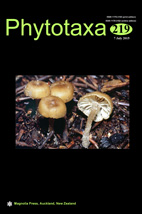Abstract
The Atlantic Forest of Brazil includes one of the highest species diversity and endemism in the planet, representing a priority for biodiversity conservation. A new species of Anemopaegma from the Atlantic Forest of Brazil is here described, illustrated and compared to its closest relatives. Anemopaegma nebulosum Firetti-Leggieri & L.G. Lohmann has been traditionally treated as a morph of Anemopaegma prostratum; however, additional morphological and anatomical studies indicated that A. nebulosum differs significantly from A. prostratum and is best treated as a separate species. More specifically, A. nebulosum is characterized by elliptic and coriaceous leaflets (vs. ovate to orbicular and membranaceous in A. prostratum), smaller leaflet blades (3.6–5.5 x 2.0–3.0 cm vs. 6.7–13.0 x 4.2–8.4 cm in A. prostratum), orbicular prophylls of the axillary buds (vs. no prophylls in A. prostratum), solitary flowers (vs. multi-flowered axillary racemes in A. prostratum) and a gibbous corolla (vs. infundibuliform corollas in A. prostratum). In addition, A. nebulosum differs from A. prostratum anatomically in having thicker leaflet blades composed of two to four layers of palisade parenchyma (vs. one to three layers in A. prostratum), and seven to eight layers in the spongy parenchyma (vs. six to eight layers in A. prostratum). A key for the identification of all species of Anemopaegma from the Atlantic Forest of Brazil is presented.

